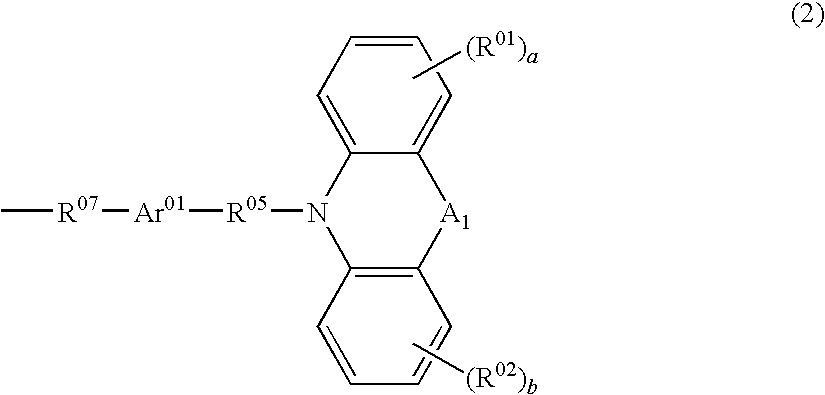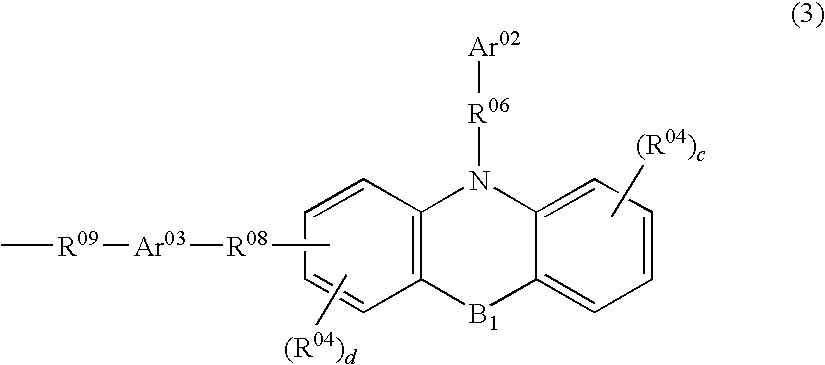Polymer and polymeric luminescent element employing the same
a technology of luminescent elements and polymers, applied in the field of polymer compounds and polymer luminescent devices, can solve the problems of insufficient luminescent materials of polymer compounds mentioned above, and achieve the effect of excellent luminescent properties and high performan
- Summary
- Abstract
- Description
- Claims
- Application Information
AI Technical Summary
Benefits of technology
Problems solved by technology
Method used
Image
Examples
example 1
Synthesis of Monomer (1)
Synthesis Example (1)
[0294]A compound (A) (5.0 g) shown below:
and phenoxazine (2.56 g) were dissolved in o-dichlorobenzene (60 g). To this solution, a 40% aqueous sodium hydroxide solution was added and then benzyltriethylammonium chloride (3.2 g) was added. The reaction was performed at 105° C. for 25 hours. Note that the reaction was performed under a nitrogen gas atmosphere.
[0295]After completion of the reaction, the solution was cooled, and allowed to stand still, and then, the upper layer separated was recovered. After the solution was washed with ion exchanged water, the solvent was distilled away under reduced pressure. Then, to the solution, toluene (40 g) was added. After filtration, the solution was passed through a column charged with alumina to purify. The solvent was distilled away from the resultant solution under reduced pressure and dried under reduced pressure to obtain 2.0 g of the monomer (1) shown below:
[0296][H-NMR: solvent CDCl3; 1.5˜1.8...
example 2
Synthesis of Polymer Compound 2
[0302]A monomer (2)(0.61 g) represented by the following formula:
the monomer (1) (0.19 g) and 2,2′-bipyridyl (0.7 g) were supplied to a reaction container and the atmosphere of the reaction system was replaced with nitrogen gas. To this, 50 g of tetrahydrofuran (dehydrated solvent), which was degassed by bubbling with argon gas in advance, was added. Subsequently, 1.24 g of bis(1,5-cyclooctadiene)nickel(0) was added to the solution mixture, and the reaction was performed at room temperature for 32 hours. Note that the reaction was performed under a nitrogen gas atmosphere.
[0303]After completion of the reaction, a methanol (40 ml) / ion exchanged water (40 ml) solution mixture was added to the solution, and the mixture was stirred for about 1 hour. The precipitate generated was collected by filtration. Subsequently, the precipitate was dried under reduced pressure and dissolved in toluene. After the toluene solution was filtrated to remove insoluble matte...
example 3
Synthesis of Monomer (4)
Synthesis Example (2)
[0314]The following compound (C) (7.4 g):
and phenoxazine (2.7 g) were dissolved in o-dichlorobenzene (60 g). To this solution, a 40% aqueous sodium hydroxide solution was added and then benzyltriethylammonium chloride (3.2 g) was added. The reaction was performed at 105° C. for 25 hours. Note that the reaction was performed in a nitrogen gas atmosphere.
[0315]After completion of the reaction, the solution was cooled, allowed to stand still and separated, and then, the upper layer was recovered. Subsequently, the solution was washed with ion exchanged water and the solvent was distilled away under reduced pressure. Then, to the solution, toluene (40 g) was added. After filtration, the solution was passed through a column charged with alumina to purify. The solvent was then distilled away under reduced pressure. The precipitate obtained was washed with methanol and dried under reduced pressure to obtain 2.7 g of the monomer (4) shown below:
[...
PUM
| Property | Measurement | Unit |
|---|---|---|
| thickness | aaaaa | aaaaa |
| fluorescent | aaaaa | aaaaa |
| phosphorescent | aaaaa | aaaaa |
Abstract
Description
Claims
Application Information
 Login to View More
Login to View More - R&D
- Intellectual Property
- Life Sciences
- Materials
- Tech Scout
- Unparalleled Data Quality
- Higher Quality Content
- 60% Fewer Hallucinations
Browse by: Latest US Patents, China's latest patents, Technical Efficacy Thesaurus, Application Domain, Technology Topic, Popular Technical Reports.
© 2025 PatSnap. All rights reserved.Legal|Privacy policy|Modern Slavery Act Transparency Statement|Sitemap|About US| Contact US: help@patsnap.com



